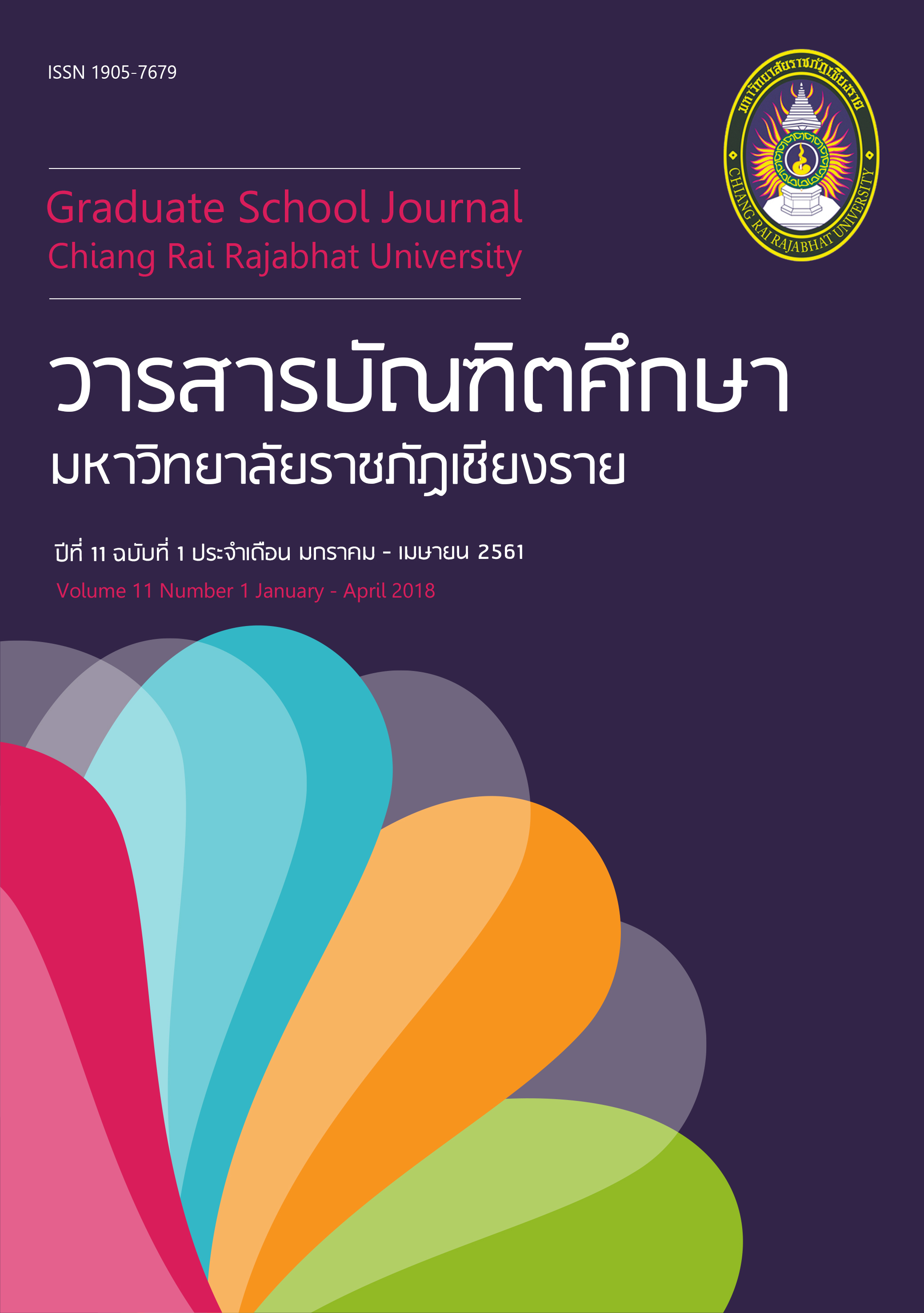The Causal Factors Affecting Happiness in the Study of Undergraduate Students at Chiang Rai Rajabhat University
Main Article Content
Abstract
The objectives of this study were: 1) to examine happiness in the study of undergraduate students at Chiang Rai Rajabhat University; 2) to investigate congruency of the causal factors model affecting happiness in the study of undergraduate students at Chiang Rai Rajabhat University based on the empirical data; and 3) to analyze the factors holding collective direct and indirect effect towards happiness in the study of undergraduate students at Chiang Rai Rajabhat University using path analysis. The samples were 450 Chiang Rai Rajabhat University undergraduate students selected by stratified random sampling in their 2014 academic year. Thirty factors were used in the analysis and questionnaire was used in collecting the data. The findings showed that: 1. Happiness in the study of undergraduate students at Chiang Rai Rajabhat University, in overall, was found at the high level. Also, the students held happiness in the study at the high level in all aspects except the anxiety aspect was found at the moderate level. The students held happiness in the study at the high level on self-satisfaction, then followed by eager to learn and satisfaction with the study respectively. 2. The investigate congruency of the causal factors model affecting happiness in the study of undergraduate students at Chiang Rai Rajabhat University based on the empirical data when considering that qui-square value appeared at χ2 = 21.34, df = 39 and the probability value was at 0.36 in which the qui-square value was different from zero without any statistical significance level. This mean that the result does not refuse the hypothesis that the theoretical model is correlated to the evidence-based data in which the goodness of Fit Index: GFI appeared at 1.00, the Adjusted Goodness of Fit Index: AGFI was at 0.97, the Root Mean Squared Residual: RMR was at 0.010, the Q-Plot graph was steeper than the transverse line, and the predictive coefficient or R–SQUARE of the happiness in the study variable appeared at 0.86 which illustrated that the variable in model could explain the variance in the happiness in the study variable at 86 persent. 3. The analysis results on collective direct and indirect effect of the factors affecting happiness in the study of undergraduate students at Chiang Rai Rajabhat University were the following. 3.1 At the confidence level of .01, the factor holding the highest collective effect towards happiness in the study of undergraduate students at Chiang Rai Rajabhat University was learner-centered instruction with the effect size of 0.64. However, the factors held no statistical significance towards happiness in the study of undergraduate students were student attributes with the effect size of -0.63, self-esteem with the effect size of 0.47, university environment with the effect size of -0.42, teacher attributes with the effect size of -0.28, and family attributes with the effect size of 0.12 respectively. 3.2 The factor holding the highest direct effect towards happiness in the study of undergraduate students at Chiang Rai Rajabhat University was learner-centered instruction with effect size of 3.23, followed by teacher attributes with the effect size of -1.74, student attributes with the effect size of -0.63, self-esteem with the effect size of 0.47, university environment with the effect size of -0.42, and family attributes with the effect size of 0.11 respectively. 3.3 The factor holding the highest indirect effect towards happiness in the study of undergraduate students at Chiang Rai Rajabhat University was teacher attributes with the effect size of 0.53, followed by learner-centered instruction with the effect size of 0.41 and family attributes with the effect size of 0.01 respectively.
Article Details
บทความที่ได้รับการตีพิมพ์เป็นลิขสิทธิ์ของวารสารมหาวิทยาลัยราชภัฎเชียงราย
ข้อความที่ปรากฏในบทความแต่ละเรื่องในวารสารวิชาการเล่มนี้เป็นความคิดเห็นส่วนตัวของผู้เขียนแต่ละท่านไม่เกี่ยวข้องกับมหาวิทยาลัยราชภัฎเชียงราย และคณาจารย์ท่านอื่นๆในมหาวิทยาลัยฯ แต่อย่างใด ความรับผิดชอบองค์ประกอบทั้งหมดของบทความแต่ละเรื่องเป็นของผู้เขียนแต่ละท่าน หากมีความผิดพลาดใดๆ ผู้เขียนแต่ละท่านจะรับผิดชอบบทความของตนเองแต่ผู้เดียว
References
โครงการศึกษา ในมหาวิทยาลัยสำหรับผู้สูงอายุในจุฬาลงกรณ์มหาวิทยาลัย. กรุงเทพมหานคร:
จุฬาลงกรณ์มหาวิทยาลัย.
เฉลียว บุรีภัคดี. (2559). ลักษณะของครูที่ดี. สืบค้นเมื่อวันที่ 20 สิงหาคม 2559, จาก
https://www.gotoknow.org/posts/317579.
ธำรง อุดมไพจิตรกุล. (2544). สังคมศาสตร์การศึกษา. กรุงเทพมหานคร: โครงการตำราคณะสังคมศาสตร์
มหาวิทยาลัยศรีนครินทรวิโรฒประสานมิตร.
นุสรา งามเดช, และคณะ. (2552). ความสุขของนักศึกษาพยาบาล. สระบุรี: วิทยาลัยพยาบาลบรมราชชนนี.
บุญส่ง นิลแก้ว. (2532). การวัดผลทางจิตวิทยา. เชียงใหม่: คณะมนุษยศาสตร์ มหาวิทยาลัยเชียงใหม่.
ปรัชญา เวสารัชช์. (2554). หลักการจัดการศึกษา. กรุงเทพมหานคร: ภาพพิมพ์.
ปรีชา เปี่ยมพงศ์สานต์. (2547). นิเวศวิทยาการเมืองและมโนทัศน์แห่งความยั่งยืนยาวนาน. กรุงเทพมหานคร:
จุฬาลงกรณ์มหาวิทยาลัย.
ปัทมา ทองสม. (2554). การพัฒนาดัชนีชี้วัดความสุขในการเรียนของนักศึกษาหลักสูตรพยาบาลศาสตรบัณฑิต
สังกัดกระทรวงสาธารณสุข. วารสารการพยาบาลและการศึกษา, 4(1), 88 - 110.
ผ่องลักษณ์ จิตต์การุญ. (2549). สภาพปัจจัยในการสอนที่ส่งเสริมการเรียนรู้อย่างมีความสุข สำหรับนักศึกษา
โปรแกรมวิชานิเทศศาสตร์สถาบันราชภัฏกลุ่มภาคเหนือตอนล่าง. พิษณุโลก: สถาบันราชภัฏ
พิบูลสงคราม.
มหาวิทยาลัยราชภัฏเชียงราย. (2558). คำสั่งที่ 4848/2558 เรื่องแต่งตั้งอาจารย์ที่ปรึกษา. 11 กันยายน 2558.มารุต พัฒผล. (2546). การจัดการเรียนรู้ที่เสริมสร้างการรู้คิดและความสุขในการเรียนรู้. กรุงเทพมหานคร:
จรัลสนิทวงศ์การพิมพ์.
สิทธิชัย จันทานนท์. (2554). การจัดกิจกรรมการเรียนการสอนที่เน้นผู้เรียนเป็นสำคัญ. สืบค้นเมื่อ
วันที่ 20 สิงหาคม 2559, จาก https://cms.srivikorn.ac.th/svk_forum/index.php?topic=3912.0.
เสาวลักษม์ กิตติประภัสร. (2555). ก้าวย่างใหม่ในการพัฒนาสู่สังคมแห่งความสุข. กรุงเทพมหานคร:
สำนักงานพัฒนานโยบายสาธารณะ.
Boomsma, A. (1983). On the robustness of LISREL (Maximum Likelihood Estimation) against
small sample size and non-normality. Sociometric Research Foundation: Amsterdam.

